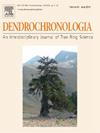裂叶雪松木材形成机制。在极端年份:气候、解剖和化学预测
IF 2.7
3区 农林科学
Q1 FORESTRY
引用次数: 0
摘要
亚马逊地区的极端气候事件揭示了外源和内源变量之间的相互作用如何在广泛分布的树种(如雪松)的木材形成中发生的问题。本研究选取了生长在亚马逊盆地南部非淹水森林上的11棵大裂木(C. fissilis)种群的成熟期树木,以确定气候(降水、温度和湿度)指标之间的相互作用:降水减去潜在蒸散量(P- pet)和标准化降水蒸散指数(SPEI)、化学(Al、P、S、Ca、K、Mn、Fe、Sr的木质部浓度及其有意义的摩尔比)和解剖学(血管比例- PV、纤维- PF和实质- PP)预测因子解释环宽(RW)和木材密度(平均- RD、最小- MND和最大- MXD)的变异性。应用决策树回归来理解三个数据集中的这种相互作用,窄或低密度,自满和宽或密集环的值。窄环或宽环与液压组织(PV)和SPEI有很大的关系。较低密度和自闭(密度值)环的变化主要与结构组织(PF)和参与土壤根系相互作用(Al)的元素以及对水分胁迫的抗性(Ca/Mn)有关。低密度MXD的变化与储存和运输组织(PP)和参与土壤根系相互作用的元素(Al和Mn)有关,而高密度MXD的变化与结构(PF)和水力(PV)组织、降水和形成层活性相关元素(Ca和K/Ca)有关。在该地区干旱的频率和强度增加的情况下,预计在C. fissilis中形成较窄和较不密集的环。从这个意义上说,我们的研究结果表明,在这些极端条件下,较高的变量值确保了这些变量的功能,与较高比例的结构组织有关,而不利于水力组织,此外,木质部中较高的K、Mn和Al储存,分别介导基于细胞扩张的形成层活性,减少对水分胁迫的脆弱性,以及更健康的根系条件。总的来说,这项研究提供了一些线索,帮助我们理解在极端水分胁迫下与木材形成相关的变量组合,这些变量可能导致水力破坏、碳饥饿、脆弱性增加,甚至物种枯死。本文章由计算机程序翻译,如有差异,请以英文原文为准。
Wood formation mechanisms of Cedrela fissilis Vell. in extreme years: Climatic, anatomical and chemical predictors
Extreme climatic events in the Amazon region open questions about how the interactions between exogenous and endogenous variables occur in the wood formation of widely distributed tree species such as Cedrela fissilis Vell. In this study, eleven mature-phase trees from a C. fissilis population growing on a non-flooded forest in the southern Amazon basin were selected to determine the interaction between climatic (precipitation, temperature, and moisture indicators: precipitation minus potential evapotranspiration - P-PET and standardized precipitation evapotranspiration index - SPEI), chemical (xylem concentrations of Al, P, S, Ca, K, Mn, Fe, Sr and their meaningful molar ratios) and anatomical (proportion of vessels – PV, fibres – PF, and parenchyma – PP) predictors to explain the variability of ring width (RW) and wood densities (average – RD, minimum – MND, and maximum – MXD). Decision tree regression was applied for understand this interaction in three datasets, values of narrow or less dense, complacent, and wide or dense rings. Narrow or wider rings vary manly associated to hydraulic tissues (PV) and SPEI. Less dense and complacent (in density values) rings vary manly associated to structural tissues (PF) and elements involved in soil-root interactions (Al) and resistance to water stress (Ca/Mn). Less dense MND vary associated to storage and transportation tissues (PP) and elements involved in soil-root interactions (Al and Mn), whereas dense MXD vary associated to structural (PF) and hydraulic (PV) tissues, precipitation and elements related to cambial activity (Ca and K/Ca). In the context of an increase in the frequency and intensity of droughts in the region, the formation of narrower and less dense rings in C. fissilis is expected. In this sense, our results suggest that higher values, which ensure the functionality of these variables under these extreme conditions, are associated with a higher proportion of structural tissues to the detriment of hydraulic ones, in addition to higher K, Mn, and Al storage in the xylem, which mediate cambial activity based on cell expansion, reduced vulnerability to water stress, and healthier root system conditions, respectively. Altogether, this study offers clues to understand variables combination associated with wood formation in the face of extreme water-availability stress that can lead hydraulic failure, carbon starvation, increasing vulnerability, and even specie´s dieback.
求助全文
通过发布文献求助,成功后即可免费获取论文全文。
去求助
来源期刊

Dendrochronologia
FORESTRY-GEOGRAPHY, PHYSICAL
CiteScore
5.50
自引率
13.30%
发文量
82
审稿时长
22.8 weeks
期刊介绍:
Dendrochronologia is a peer-reviewed international scholarly journal that presents high-quality research related to growth rings of woody plants, i.e., trees and shrubs, and the application of tree-ring studies.
The areas covered by the journal include, but are not limited to:
Archaeology
Botany
Climatology
Ecology
Forestry
Geology
Hydrology
Original research articles, reviews, communications, technical notes and personal notes are considered for publication.
 求助内容:
求助内容: 应助结果提醒方式:
应助结果提醒方式:


